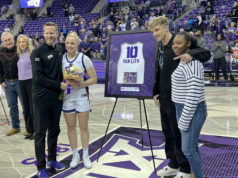If you’ve never been to a college gymnastics meet, you may not realize the experience goes well beyond seeing if a competitor can earn an elusive “10” from the judges. It’s quite the sensory experience, too, with multiple events going on simultaneously. You might find yourself in the middle of marveling at some extraordinary tumbling in the floor exercise when the roar of nearby cheering section alerts you that you missed a competitor sticking her landing on the uneven bars. Those fans, mostly sitting together in their team colors, are into it big-time and add to the atmosphere, as does the almost constant music during competition.
Add to that the moxie and agility of the competitors and Saturday’s National Collegiate Women’s Gymnastics Championship at Fort Worth’s Dickies Arena made for an entertaining sporting spectacle.
The previous evening I had been in Dallas’s Fair Park Coliseum watching a different sport. Athletes Unlimited’s female professional volleyball players also delivered athleticism and skill aplenty.
The back-to-back events made me think about a point of view I’ve always considered odd: some people don’t like women’s sports.
It’s not that they necessarily think women or girls shouldn’t play sports (although there are surely still some of those men out there). It’s that they simply dismiss them as not spectating-worthy. The argument often runs that they’re not as good as the men’s pros (the 500th-ranked man would double-bagel Serena Williams) or that they lack sufficient athleticism to make watching them enjoyable (they don’t dunk).
It’s my feeling that such people are closing their minds to an athletic experience they might enjoy. Here are some reasons why:
If you’re going to declare that you can only be entertained athletically by the best of the best, you won’t have a lot to choose from. Even the major pro leagues don’t feature that. You’d need an All-Star Game (one the players take seriously) every week. And even then, how would you know who should be in it? Young players displace older ones. Players work to improve their games. Even figuring out who the best of the best are is a moving target.
What we love about sports has to do with so much more than just athletic ability. Persistence, creativity, teamwork, underdog stories – these all help us get absorbed in a game. And drama – we love that. A buzzer-beater, a comeback, even a bad beat in a wager – these all get us going. Saturday, for instance, Oklahoma had to stick landing after landing on the balance beam to hold off Florida and Trinity Thomas’s 10 on the floor exercise. The Sooners won it by .112 of a point, which is not much. The crowd was riveted.
I love a good dunk contest (to watch – like most people, male or female, I’ve regrettably never had the athletic wherewithal to participate in one), but it’s hard to imagine a person whose only enjoyment out of sport came from a singular skill only a handful of men could achieve. And, in fact, in recent years, we’ve seen women participating in many sporting activities once considered boys clubs.
One such pastime is rugby union. And, in fact, the other sporting event I attended this weekend was a match between the Austin Gilgronis and Dallas Jackals. The league in which these men play does not rank among the world’s best (think France, England, Australia, et al). But it still features professional players who compete at a high level. I still saw toughness, strategy, and competition (though unfortunately not drama, as the visitors powered past the Jackals handily). But I still enjoyed it, because even though it wasn’t “elite,” it was still pretty darn good.
It’s actually a good time to bring up rugby, because England’s national team just set an attendance record for a women’s game played in the country as they drew more than 14,000 fans to a Six Nations win over Wales.
In fact, women’s sport has shown a remarkable growth recently in such measures as attendance and TV ratings. FC Barcelona Femeni set a new record this year for attendees at a women’s soccer game as 91,553 watched the squad’s Champions League win over rival Real Madrid. The recent NCAA women’s national championship basketball game posted its highest TV ratings in almost 20 years, as did last Monday’s WNBA Draft. Ratings were up for the WNBA and NWSL in their most recent seasons.
One theory to explain this phenomenon could be that as more people give women’s sport a chance, they’re discovering they like it. They’re finding it has everything they like about sports, and maybe even adds something unique, like inspiring daughters, sisters, and nieces in a way men’s sport can’t.
The next step will be to see how well commercial entities, especially sponsors, find ways to build on this enthusiasm. The Olympics have shown for years how content around female athletes will resonate when interest exists in the competition. Revenue-generating opportunities, in turn, will filter down to the female athletes driving this interest.
Much has been made recently of the escalating value of the women’s collegiate basketball tournament. The NCAA has come in for criticism of the 2011 deal it did with ESPN in which it bundled all its rights except the domestic men’s basketball championship. Many are feeling they should have broken the women’s sporting rights out separately and gotten rights fees that better reflect their value. And it’s certainly possible the governing body was short-sighted in grouping the rights together like that. I would also note, however, that the deal ensured ESPN-quality coverage of a whole bunch of NCAA sports that might not have otherwise gotten it. Saturday’s gymnastics, for instance, ran live on ABC. Until last year, it had never aired on the national free-to-air network. Could that exposure have helped build interest in women’s sports to the point where sports like gymnastics and softball can stand on their own? And would ESPN have spent the same amount on producing NCAA Olympic sports if it had not also gotten the rights to women’s basketball? It’s hard to know. In any case, the agreement expires at the end of the 2023-24 season, so we’ll soon find out what can be achieved as the NCAA negotiates its next deal in a much-different streaming landscape.
At Friday’s volleyball matches, a player deftly kicked the ball with her back heel to keep it from hitting the ground and her team got the free ball back over the net. It was the type of athletic, instinctual play any sports fan could appreciate, no matter who made it. Athletes Unlimited has made it a priority to make sure female athletes, and a diverse group of women at that, receive professional opportunities. It’s worth noting that the play came on a day when another sport celebrates the debut of a group of previously-excluded players on its stage – Jackie Robinson Day. 75 years ago, many felt White fans would never go to watch an African American ballplayer. Luckily, they did anyway and discovered they enjoyed watching Robinson and the Black superstars who followed him steal bases, hit home runs, and win World Series. We may be seeing the same phenomenon happen in the present day with women’s sports. It could just be a matter of people giving them a chance.












